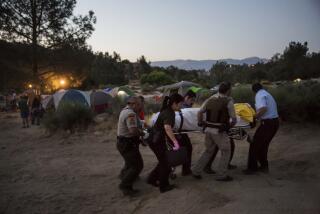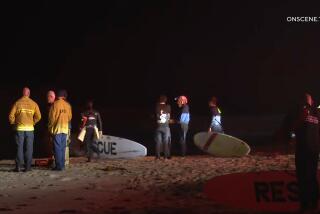Officials Urge Caution After Teen’s Drowning
- Share via
A 13-year-old boy on a school trip to the El Monte Aquatic Center drowned Thursday at the community pool.
Three lifeguards spotted the motionless boy, who was on a trip with the Mountain View School District and his 10-year-old brother, and pulled him out.
The boy was transported to Greater El Monte Community Hospital, where he was pronounced dead at 3:50 p.m., said Officer Matt Weintraub of the El Monte Police Department.
It was the first drowning at a public pool in the city in more than 40 years, Weintraub said.
According to the federal Centers for Disease Control and Prevention, 782 children through age 14 died from drowning in 2003.
Although the nation’s drowning rate has declined slowly, it remains the second-leading cause of injury-related death for children ages 1 to 14, the agency reported.
Among children ages 1 to 4, most drownings occur in residential pools.
Most young children who drowned in pools were last seen in the home, had been out of sight less than five minutes and were in the care of one or both parents at the time.
Question: What should parents do to make backyard pools safer?
Answer: According to Mark Ross, public affairs specialist at the U.S. Consumer Product Safety Commission in Washington, D.C., parents should apply layers of security.
Install barriers. A four-sided fence that is at least 4 feet high with slats that are less than 4 inches apart is one key barrier. The gates should be self-closing and self-latching, and a child should not be able to reach the latch.
Supervise. No barriers replace supervision. Always watch children in the water. If a pool is in the vicinity and a child is missing, check the pool first.
Prepare for an emergency. Have a cordless phone, emergency numbers, a first-aid kit and rescue equipment near the pool. Learn CPR and first aid.
Q: What pool rules should children follow?
A: Children should always swim with a buddy. In addition, they should never do the following:
Run near the pool.
Push or jump on others in the water.
Dive or jump into shallow water.
Q: How safe or dangerous are the inflatable toys that children frequently use in swimming pools?
A: “As with any toy, inflatable ones for the pool can be very dangerous and should be used under strict supervision,” said Julie Gilchrist, a medical epidemiologist at the Centers for Disease Control and Prevention in Atlanta.
“It’s one thing to play with an inflatable toy in the living room, but it’s another to play with it in a hazardous environment,” Gilchrist said.
Inflatable toys should never be considered a replacement for an age-appropriate, approved personal flotation device.
Q: During inclement weather, when should we exit the pool and head indoors?
A: The American Red Cross advises swimmers to get out of the pool when they see storm clouds or hear thunder.
More to Read
Sign up for Essential California
The most important California stories and recommendations in your inbox every morning.
You may occasionally receive promotional content from the Los Angeles Times.










